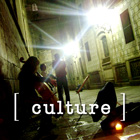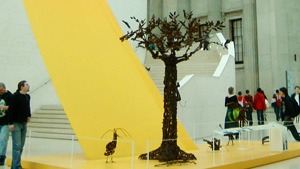
|
||||||||||||||
|
11 July 2005 In the wake of Mozambique's long civil war, lasting from 1976 to 1992, a group of artists, sponsored by Christian aid, set up the Transforming Arms into Tools (TAE) project in the nation's capital, Maputo. Sculptors use decomissioned weapons, and parts of weapons to make art, expressing the possibility of finding new ways to secure and advance civil society. The TAE project encourages people to exchange weapons for useful tools, such as sewing machines, tools for farming and other items that can help sustain a productive, if modest lifestyle. The project is thoroughly humanitarian and aims to educate people, to remind them of the horrors of war, and to show that good will is more powerful than the technology of war. The "Tree of Life" is one of the most inspired and spectacular results of the project. It was sculpted by Cristovao Canhavato (Kester), Hilario Nhatugueja, Fiel dos Santos and Adelino Serafim Maté, four artists from Mozambique. At 3.5 meters in height, the Tree of Life has been installed at the British Museum in London, as part of its year-long feature Africa 2005. The sculpture and some smaller pieces, which include fascinating renditions of regional African fauna, are touring different sites where they can deliver the message that in Mozambique culture has turned toward an enduring commitment to end armed conflict and build a society structured around creative expression and learning. Mozambique's long and arduous civil war, which began in 1976, in the wake of the collapse of Portugal's dictatorship and the withdrawal of troops from resistant former colonies, lasted for over 16 years. An estimated 1 million people were killed, upwards of 1.7 million fled into neighboring countries, and several million more were internally displaced. The wife of former South African president and Nobel laureate Nelson Mandela, Graça Machel visited the Tree of Life on 3 February, just before attending the rally for the Make Poverty History movement in London's Trafalgar Square. Machel is quoted by Christian aid, on visiting the sculpture's display at the British Museum: "When you see this Tree, you don’t just see Mozambique, you see the face of Africa. You see in the sculpture all the conflicts which have gone on in the making of it, and that’s why it’s wonderful to see the great space the British Museum has given it..." [s]
|
|||||||||||||
|
||||||||||||||



